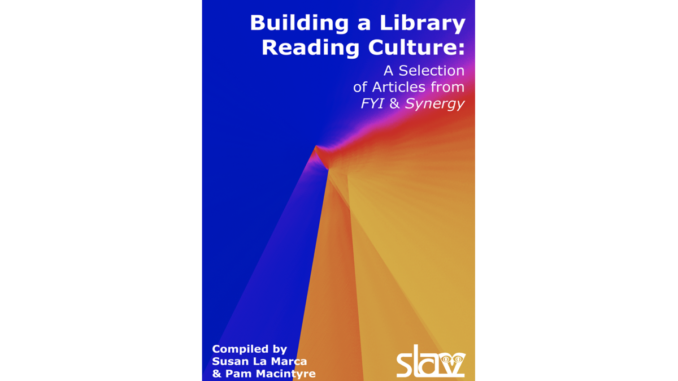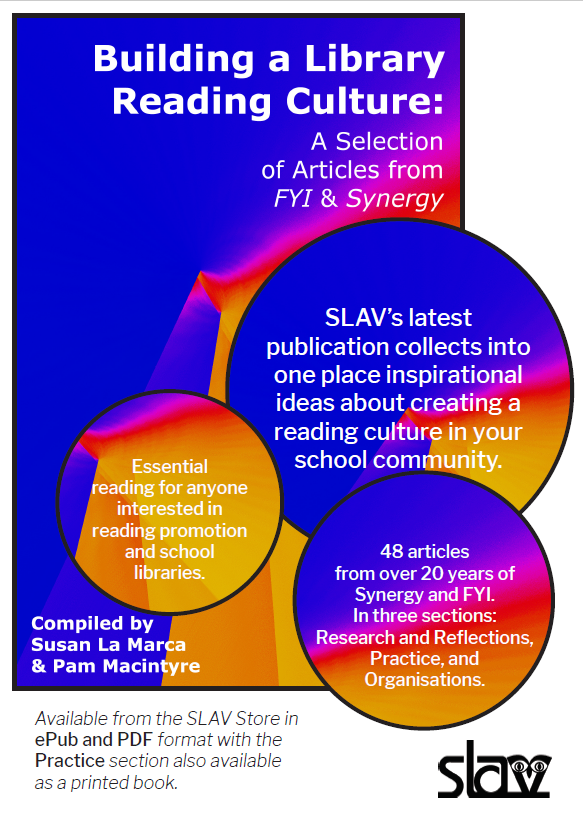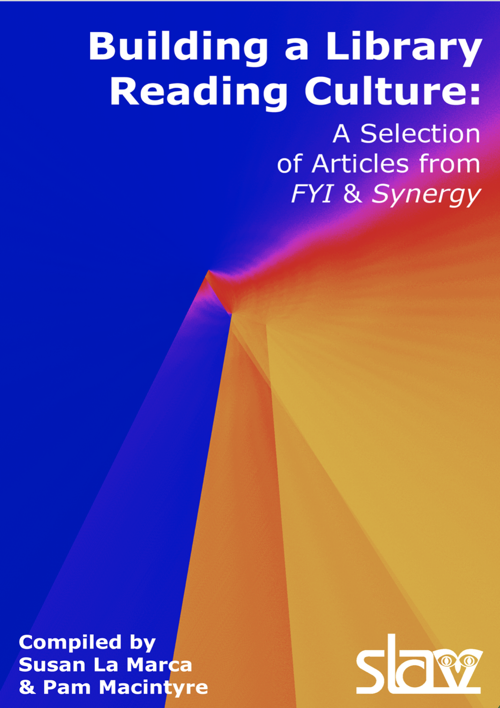
Review by Judith Sykes
Building a Library Reading Culture: A Selection of Articles from FYI & Synergy
Compiled by Susan La Marca & Pam Macintyre
Published by the School Library Association of Victoria Inc. © 2021
This book is comprised of a selection of 48 articles depicting twenty years of insight into school libraries and teacher-librarians supporting reading and readers. It is largely reflective of schools in the Australian state of Victoria where FYI is the quarterly publication of the School Library Association of Victoria (SLAV) and Synergy is published twice annually by SLAV. The articles will have broad appeal to readers everywhere though as developments over time in building reading cultures in schools are shared. Many articles focus on adolescent/teen reading and were published from 1998-2020; the emergence of COVID is mentioned briefly in 2019 article conclusions.
The book is divided into three sections – Research and Reflections, Practice, and Organisations. The “Research & Reflections” section includes articles on language/format development, processing information and reading in a digital age, teen reading studies on gender issues, what parents/educators can do to engage readers, e-book study, re-thinking collection arrangement, non-fiction texts in primary school, and inclusive collections. Articles from other countries include Singapore on building international language collections and Canada on the Canadian School Libraries (CSL) school library summer lending program, by CSL Chair Anita Brooks Kirkland.
The “Practice” section contains many school-based studies and models for practice such as “Reading” timetabled as a subject in secondary schools, classically successful tips to encourage teen reading, boys and reading using book trailers, e-readers, graphic novels. Studies highlight programs such as reading with dads, inspiring refugee readers, parent and student book clubs, student collection design by genre, literature festivals, student “banned books” club, strategies/intervention for teens to overcome reading difficulties, innovative strategies on reading aloud (story dogs), the importance of reading and conversation, nine key steps to a reading culture – evidence is one! A teen study showed independent choice as the most successful characteristic in turning reading from an instructional process to a cultural one. Co-planning is common throughout, such as the article on reading comprehension co-planned by teacher-librarians and English teachers involving reading conferencing.
The “Organisations” section references key organizations devoted to children/young adult literacy in Australia and internationally. Scholastic Australia donated original artwork, illustrations and other artifacts of many Australian children’s books to the State Library of Victoria, Australia. Author Kate Grenville writes about visiting an Indigenous community succeeding in literacy efforts. Penguin Australia sponsors funding a very successful Indigenous literacy project – $5 to enter & read 10 books (any age) co-sponsored with schools. LMERC – the Languages and Multicultural Education Resource Centre, Victoria, Australia, Department of Education & Training, is a specialised lending library for educators also with online resources. Addressing gender bias in literature, the Stella Prize for literature written by Australian women has been followed by the Stella Prize Schools Program. A school’s teen book club success leads the school to an Inky Ambassador Award, another program of the State Library of Victoria. The IASL (International Association of School Librarianship) International School Library Month Bookmark Exchange Program has been organized by volunteers for over 20 years and now has a digital addition. Part of IBBY (International Board on Books for Young People, IBBY Australia organizes literary activities and awards.
The studies, strategies and ideas presented in this book certainly resonate in Canada. Many studies or ideas could be replicated or put into practise in new, post-pandemic ways. The article topics or themes can encourage looking into similar studies in Canada such as those in the CSL Research Archive.
Recommended reading – this book invites reflection of a key component of our profession over time, is filled with many voices of fellow practitioners sharing research, ideas, and strategies, and can be read a few articles at a time, or focusing on articles pertaining to a reader’s interest or school.
Building a Library Reading Culture is available for purchase from the SLAV Store.

About our Reviewer: Judith Sykes has been a teacher, teacher-librarian, district school library specialist, and elementary school principal for the Calgary Board of Education in Alberta. She was the provincial school library manager for the Alberta Ministry of Education, leading the School Library Services Initiative 2008-2012. Judith was the project coordinator and a contributing writer for Leading Learning: Standards Of Practice For School Library Learning Commons in Canada when it was first published, and continues as co-chair of CSL’s Leading Learning Committee. She also serves on the CSL Board of Directors. Judith has published several books about school library practice, including two that deal specifically with action research approaches.

